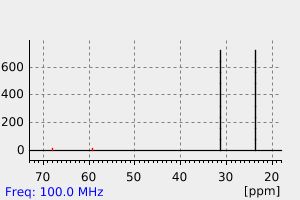di-tert-butyl thiosulfonate | 31562-41-1
中文名称
——
中文别名
——
英文名称
di-tert-butyl thiosulfonate
英文别名
S-tert-butyl 2-methylpropane-2-thiosulfonate;tert-butyl 2-methylpropane-2-sulfonothioate;t-butyl 1,1-dimethylethanethiosulfonate;S-tert-butyl tert-butanethiosulfonate;2-Tert-butylsulfonylsulfanyl-2-methylpropane
CAS
31562-41-1
化学式
C8H18O2S2
mdl
——
分子量
210.362
InChiKey
JQXYVLHDMYEKPJ-UHFFFAOYSA-N
BEILSTEIN
——
EINECS
——
-
物化性质
-
计算性质
-
ADMET
-
安全信息
-
SDS
-
制备方法与用途
-
上下游信息
-
文献信息
-
表征谱图
-
同类化合物
-
相关功能分类
-
相关结构分类
计算性质
-
辛醇/水分配系数(LogP):2
-
重原子数:12
-
可旋转键数:3
-
环数:0.0
-
sp3杂化的碳原子比例:1.0
-
拓扑面积:67.8
-
氢给体数:0
-
氢受体数:3
SDS
上下游信息
-
上游原料
中文名称 英文名称 CAS号 化学式 分子量 (S)-(-)-叔丁烷硫代亚磺酸叔丁酯 tert-butyl tert-butanethiosulfinate 31562-40-0 C8H18OS2 194.362 -
下游产品
中文名称 英文名称 CAS号 化学式 分子量 —— Di-tert-butyl vic-disulfone 98248-42-1 C8H18O4S2 242.361
反应信息
-
作为反应物:描述:参考文献:名称:Detection and Decomposition of Di-tert-butyl Disulfide-Polyoxide Derivatives摘要:The chemistry of di-tert-butyl disulfide polyoxide derivatives has been investigated. Low-temperature experiments permit the clear detection of vic-disulfoxides (alpha-disulfoxides). In addition, a proposal for a decomposition mechanism that accounts for the detection of one of the diastereoisomers and the formation of the final products has been advanced. The formation of di-tert-butyl thiosulfonate was also shown to be solvent and concentration dependent. Finally, low-temperature experiments permit the detection of the sulfinyl sulfone and vic-disulfone derivatives. A general mechanism has been proposed for the decomposition of these disulfide polyxoide derivatives.DOI:10.1021/jo00109a042
-
作为产物:描述:叔丁基二硫 在 potassium permanganate absorbed on copper(II) sulfate pentahydrate (1:3) 作用下, 反应 0.06h, 以68%的产率得到di-tert-butyl thiosulfonate参考文献:名称:Fast and efficient green synthesis of thiosulfonate S-esters by microwave-supported permanganate oxidation of symmetrical disulfides摘要:Potassium permanganate absorbed on copper(II) sulfate pentahydrate has been found to be an efficient, inexpensive, and green oxidation agent for the synthesis of "symmetrical" thiosulfonate S-esters by oxidation of the corresponding symmetrical disulfides. The oxidation reactions were carried out under solvent-free reaction conditions within 15 min under the influence of microwave irradiation, as well as (for comparison) supported by conventional heating, to afford yields of the thiosulfonate S-esters in the range of 60-83%. The oxidation reaction appears to proceed (at least partly) via an intermediate symmetrical vic-disulfoxide.DOI:10.1080/17415993.2015.1025404
文献信息
-
The antioxidant activity of polysulfides: it's radical!作者:Jean-Philippe R. Chauvin、Markus Griesser、Derek A. PrattDOI:10.1039/c9sc00276f日期:——high temperatures, produces branched polysulfides. Due to their anti-wear properties, they are indispensible additives to lubricants, but are also added to other petroleum-derived products as oxidation inhibitors. Polysulfides also figure prominently in the chemistry and biology of garlic and other plants of the Allium species. We previously reported that trisulfides, upon oxidation to their corresponding烯烃和硫在高温下一起加热的烯烃硫化,会生成支链多硫化物。由于它们的抗磨性能,它们是润滑剂必不可少的添加剂,但也可以作为抗氧化剂添加到其他石油衍生产品中。多硫化物在大蒜和葱属的其他植物的化学和生物学中也很重要物种。我们以前曾报道过,三硫化物在氧化为相应的1-氧化物后,在环境温度下是令人惊讶的有效自由基捕获抗氧化剂(RTA)。在这里,我们表明负责的均质取代机制也适用于四硫化物,但不适用于三硫化物,二硫化物或硫化物。此外,我们表明,这种反应性在高温(160°C)时仍保持不变,使四硫化物不仅能使其1氧化物(即RTA)黯然失色,而且还可以阻止最常见的工业抗氧化剂添加剂酚和烷基化二苯胺。该反应性是高级多硫化物(n≥4),因为在S2上对其进行均质取代会产生稳定的Perthiyl自由基。相对于1-氧化物,在较高温度下,聚硫醚基团的持久性也使多硫化物具有更高的反应性,因为前者可逆地分解S-S键,而后者则不可
-
Direct Conversion of Arylamines to the Halides by Deamination with Thionitrite or Related Compounds and Anhydrous Copper(II) Halides作者:Shigeru Oae、K\={o}ichi Shinhama、Yong Hae KimDOI:10.1246/bcsj.53.1065日期:1980.4Reactions of various arylamines with either t-butyl thionitrite, t-butyl thionitrate, or p-toluenesulfonyl nitrite in the presence of anhydrous copper(II) halides under mild conditions gave corresponding aryl halides in good yields. This reaction in the presence of such olefins as acrylonitrile, styrene, and acrylic acid gave the corresponding 2-aryl-1-haloethanes as the main products. t-Butyl thionitrite
-
A Kinetic Study ofS-Nitrosothiol Decomposition作者:Loris Grossi、Pier Carlo MontevecchiDOI:10.1002/1521-3765(20020118)8:2<380::aid-chem380>3.0.co;2-p日期:2002.1.18Under anaerobic conditions S-nitrosothiols 1a-e undergo thermal decomposition by homolytic cleavage of the S-N bond; the reaction leads to nitric oxide and sulfanyl radicals formed in a reversible manner. The rate constants, k(t), have been determined at different temperatures from kinetic measurements performed in refluxing alkane solvents. The tertiary nitrosothiols 1c (k1(69 degrees C) = 13 x 10(-3)在厌氧条件下,S-亚硝基硫醇1a-e通过SN键的均相裂解而发生热分解。该反应导致可逆地形成一氧化氮和亚硫烷基。速率常数k(t)已在不同温度下根据在回流烷烃溶剂中进行的动力学测量确定。叔亚硝基硫醇1c(k1(69摄氏度)= 13 x 10(-3)min(-1))和1d(k1(69摄氏度)= 91 x 10(-3)min(-1))分解更快比主要亚硝基硫醇1a(k1(69摄氏度)= 3.0 x 10(-3)min(-1))和1b(k1(69摄氏度)= 6.5 x 10(-3)min(-1))。活化能(E#= 20.5-22.8 Kcal mol(-1))已根据Arrhenius公式计算得出。在有氧条件下,S-亚硝基硫醇1a-e的降解是由N2O3催化的自催化链分解过程引起的。后者通过双氧与内源性和/或外源性一氧化氮反应形成。通过去除内源性一氧化氮或存在抗氧化剂(例如对甲酚,β-苯乙烯和BHT),强
-
Direct Conversion of Arylamines to the Corresponding Halides, Biphenyls, and Sulfides with<i>t</i>-Butyl Thionitrate作者:Shigeru Oae、K\={o}ichi Shinhama、Yong Hae KimDOI:10.1246/bcsj.53.2023日期:1980.7t-Butyl thionitrate have been found to be an excellent diazotizing reagent of arylamines in aprotic nonpolar media, affording eventually such products as aryl chlorides, aryl bromides, aryl iodides, biphenyls, and aryl methyl sulfides in the presence of CCl4, CHBr3, I2, benzene, and dimethyl disulfide, respectively, via extrusion of N2.
-
Asymmetric synthesis of chiral organosulfur compounds using N-sulfinyloxazolidinones作者:David A. Evans、Margaret M. Faul、Lino Colombo、John J. Bisaha、Jon Clardy、David CherryDOI:10.1021/ja00041a011日期:1992.7which may be readily purified by chro- matography. These sulfinylating agents react with a wide range of nucleophiles such as Grignard reagents, enolates, lithium alkoxides, or metalated amides, with inversion of configuration at the sulfur center to afford the derived chiral sulfoxides, sulfinate esters, and sulfinamides in high yields and enantioselectivities. Competition experiments have established
表征谱图
-
氢谱1HNMR
-
质谱MS
-
碳谱13CNMR
-
红外IR
-
拉曼Raman
-
峰位数据
-
峰位匹配
-
表征信息
同类化合物
辛基甲烷硫代磺酸酯
辛基二砜
蚜灭多砜
蔊菜素
羟基十四烷磺酸钠
糖芥灵
磺酰基二乙睛
磺酰基二[三溴甲烷]
硫酸丙酯
硫酰二丙腈(SDPN)
硫甲磺酸钠
硫氰酸硫酯
硫杂环丁烷-3-羧酸1,1-二氧化物
硫杂环丁烷-1,1-二氧化物
砜吸磷
甲磺酰乙酸甲酯
甲磺酰乙酸
甲磺酰乙酮
甲烷磺酰基氰化物
甲烷磺酰基叠氮化物
甲烷磺酰基乙酸乙酯
甲烷硫代磺酸戊酯
甲烷硫代磺酸丁酯
甲烷硫代磺酸S-(三氯乙烯基)酯
甲烷硫代磺酸 S-(2-羟基乙基-1,1,2,2-D4)酯
甲基磺酰基甲胺
甲基磺酰基甲基磺酰基甲烷
甲基磺酰基甲基二硫基甲基磺酰基甲烷
甲基磺酰乙腈
甲基硫代磺酸甲酯
甲基癸基砜
甲基乙烯砜
甲基乙基砜
甲基3-(乙基磺酰基)丙酸酯
甲基-三聚乙二醇-砜-四聚乙二醇-炔基
环戊基磺酰基环己烷
环己烷,[[(三氟甲基)磺酰]乙炔基]-
环己基三氟甲基砜
环丙胺,N-[2-(2,4,5-三甲基苯氧基)乙基]-
特丁硫磷氧砜
烯丙基二甲基砜
炔基-四聚乙二醇-SULFONE-四聚乙二醇-羧酸
炔基-三聚乙二醇-SULFONE-三聚乙二醇-炔基
溴甲基甲烷硫代磺酸酯
涕灭砜威
氯甲基叔丁基砜
氯甲基三氯甲基砜
氯(甲磺酰基)甲烷
氯(甲磺酰基)乙烷
氯(氯甲基磺酰基)甲烷







